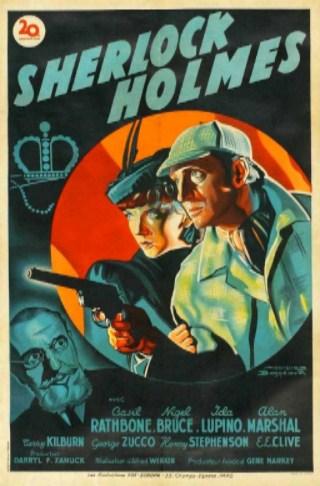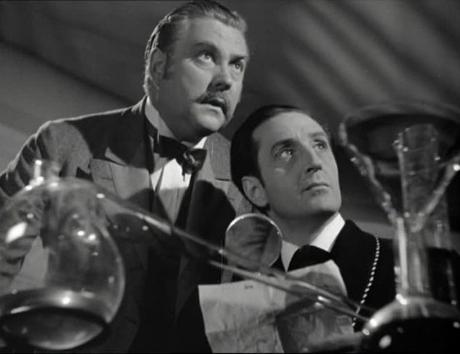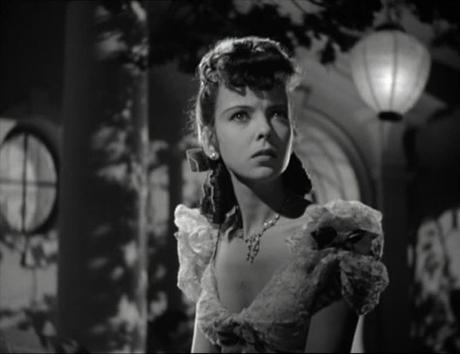
I'm going to break you Holmes. I'm going to bring off right under your nose the most incredible crime of the century, and you'll never suspect it until it's too late. That will be the end of you Mr. Sherlock Holmes. And when I've beaten and ruined you then I can retire in peace. I'd like to retire; crime no longer amuses me. I'd like to devote my remaining years to abstract science.
The Sherlock Holmes character has come to the screen (both big and small) in many shapes and forms over the years and almost everyone has their own favorite incarnation. As often happens, the first version I saw or at least have a memory of has become my preferred choice. For me, the evening television screenings of the Basil Rathbone and Nigel Bruce movies cemented them in my consciousness to the point where I automatically see their faces first when the characters of Holmes and Watson are mentioned. The interpretations, adaptations and settings were far from what a purist might find acceptable, but I don't care about any of that. These performers and their films carry me back almost 40 years and will always occupy a special place in my affections.
The Adventures of Sherlock Holmes (1939) wasn't an adaptation of any of Conan Doyle's stories, although the estate is credited, presumably for the use of the characters themselves. The script instead claims to be derived from the stage play by William Gillette. It opens with the dismissal of a murder case against arch-criminal Professor Moriarty (George Zucco), just as Holmes (Basil Rathbone)dramatically bursts into the courtroom with evidence he maintains will shoot the alibi of his adversary to pieces. With the verdict already in, he's too late of course and there follows a neat little scene with the two rivals sharing a Hansom cab that spirits them away amid a torrential downpour. It's at this point that Moriarty makes the little speech I used at the top of this piece, setting up the plan for revenge which dominates the remainder of the picture. I won't go into too much detail here as much of the pleasure of the movie is to be had from watching the slow unfolding of two ingenious plot strands simultaneously. The lion's share of the running time is taken up with the grotesque and macabre stalking experienced by Ann Brandon (Ida Lupino) and her ill-fated relatives.

1939 is often referred to as the golden year of cinema's Golden Age due to the sheer number of successful and high quality pictures produced and released during those twelve months. This is something I wouldn't want to argue with as even a cursory glance reveals the depth and breadth of the quality projected onto the silver screen in that year - from award-wooing prestige vehicles to crowd-pleasing genre pieces, just about every possible taste was catered to and it would be a mean-spirited film fan indeed who failed to hit on something to captivate him or her. Last time I was highlighting a tightly budgeted western shot by Alfred Werker, this time it's the same director but the money men were a little more generous. Fox had already scored a success with Rathbone and Bruce in their wonderfully atmospheric version of The Hound of the Baskervilles and this was their follow-up. Werker had the resources of the studio backing him up in this moodily impressive effort, the sets looking rich and classy and Leon Shamroy displaying his photographic talents as cinematographer. There's been some conversation on here of late relating to the relative merits of set based film production after I looked at a movie where I felt the backdrops were less than satisfactory. The Adventures of Sherlock Holmes, on the other hand, presents us with the flip side of the coin, where much of the enjoyment of the movie stems directly from the marvelous artistry involved in creating those fogbound and gas-lit cobble streets down which hacks chase their cabs speeding their fares to or from the scene of mystery and intrigue.
The two films made by Fox had Holmes and Watson fighting crime in the Victorian surroundings in which their creator had originally placed them. Subsequent tales of mystery and detection undertaken by Rathbone and Bruce would be produced on a smaller budget for Universal (my friend and regular contributor to discussion on this site, Sergio, is in the process of going through that series here, and others like 100 Films in a Year have done so too) with the characters operating in a contemporary setting. Purists may rail against such liberties but they never concerned me particularly. The Adventures of Sherlock Holmes retains the era of Conan Doyle's literary detective yet it will no doubt displease some as a result of the way certain central characters are portrayed.

Is there a definitive screen Holmes? Plenty of people would argue that Jeremy Brett nailed it on television. Having gone back and revisited a number of episodes of the Brett series, I'd say there's a strong case to be made for this assertion and I wouldn't seek to dissuade anyone from holding this opinion. And still I find I return to Rathbone, for those reasons I mentioned above; I've since read the novels and short stories and seen other interpretations that may have gotten closer to the sleuth on the printed page, but Rathbone was the one I came across first and thus will always be my Holmes. There's a terrific energy and restlessness about the man and it contrasts nicely with the moody abruptness which can bubble up to the surface on occasion. Nigel Bruce's Watson tends to come in for a fair bit of stick and derision for the bumbling and clowning, and I can quite understand how that must grate for those familiar with the capable and competent figure of the books. Sure there's something of the overgrown child about Bruce's performance, even so I like it fine and there's good chemistry between him and Rathbone - I think the affection the characters have for each other is quite apparent and nicely illustrated by the little exchange right at the end of the movie. As Moriarty, George Zucco is delightfully creepy and dangerous. He would reappear in the Universal film Sherlock Holmes in Washington, though playing a different role. A young Ida Lupino was just seeing her career take off at this point and I think she does well as the girl whose family appears to be cursed in some way and haunted by dark South American secrets. In support, we have E E Clive, Henry Stephenson, Alan Marshal, series regular Mary Gordon, and Terry Kilburn.
I have all the Rathbone/Bruce series on the UK set issued some years ago by Optimum and the transfers sourced from the UCLA restorations are very good. There's some damage to the prints of course but nothing major. Among the extra features on The Adventures of Sherlock Holmes is a commentary track by Holmes writer David Stuart Davies. It's worth noting here that there are various Blu-ray editions of these films available both in the US and in Europe - I've yet to pick one up but the quality is excellent by all accounts. As for this movie, it's a fine tale with bags of creepy atmosphere and ought to satisfy fans of Holmes and the wider mystery genre too. It would serve as a good introduction to the Rathbone/Bruce take on Holmes and Watson and the brisk pacing is such that it never outstays its welcome.
